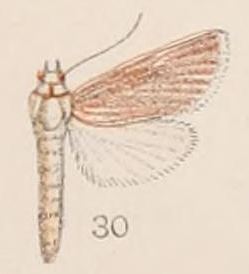
Patissa is a genus of moths of the family Crambidae erected by Frederic Moore in 1886.

Acylita distincta is a species of moth of the family Noctuidae first described by E. Dukinfield Jones in 1908. It is found in Brazil. Its wingspan is about 26 mm.
Patissa geminalis is a moth in the family Crambidae. It was described by George Hampson in 1919. It is found in Kenya, Malawi, Tanzania, Uganda and Zimbabwe.
Patissa fractilinealis is a moth in the family Crambidae. It was described by George Hampson in 1919. It is found in Kenya and Uganda.
Patissa fulvicepsalis is a moth in the family Crambidae. It was described by George Hampson in 1919. It is found in Malawi, Nigeria and Uganda.
Patissa fulvipunctalis is a moth in the family Crambidae. It was described by George Hampson in 1919. It is found in Uganda.
Patissa monostidzalis is a moth in the family Crambidae. It was described by George Hampson in 1919. It is found in Nigeria.
Patissa ochreipalpalis is a moth in the family Crambidae. It was described by George Hampson in 1919. It is found on Mayotte off the coast of Southeast Africa.
Patissa rubrilinealis is a moth in the family Crambidae. It was described by George Hampson in 1919. It is found in Malawi.
Patissa rufitinctalis is a moth in the family Crambidae. It was described by George Hampson in 1919. It is found in Sierra Leone.
Patissa termipunctalis is a moth in the family Crambidae. It was described by George Hampson in 1919. It is found in Malawi.
Haritalodes polycymalis is a moth in the family Crambidae. It was described by George Hampson in 1912. It is found in the Democratic Republic of the Congo, Guinea, Ivory Coast, Kenya, Madagascar, Malawi, Mozambique, Sierra Leone, South Africa (KwaZulu-Natal), Tanzania and Uganda.
Pilocrocis dichocrosialis is a moth in the family Crambidae. It was described by George Hampson in 1912. It is found in Cameroon, the Democratic Republic of the Congo (Katanga), Malawi, Mozambique, Zambia and Zimbabwe.
Pilocrocis melastictalis is a moth in the family Crambidae. It was described by George Hampson in 1912. It is found in South Africa and Zimbabwe.
Pilocrocis pterygodia is a moth in the family Crambidae. It was described by George Hampson in 1912. It is found in Ghana, South Africa, Uganda and Zimbabwe.
Sameodes microspilalis is a moth in the family Crambidae. It is found in Zimbabwe.
Syllepte attenualis is a moth in the family Crambidae. It was described by George Hampson in 1912. It is endemic to Kenya.
Udea phaealis is a moth in the family Crambidae. It was described by George Hampson in 1899. It is found in Orizaba, Mexico.
Udeoides muscosalis is a moth in the family Crambidae. It was described by George Hampson in 1913. It is found in Kenya and South Africa.
Udeoides nigribasalis is a moth in the family Crambidae. It was described by George Hampson in 1913. It is found in Kenya.